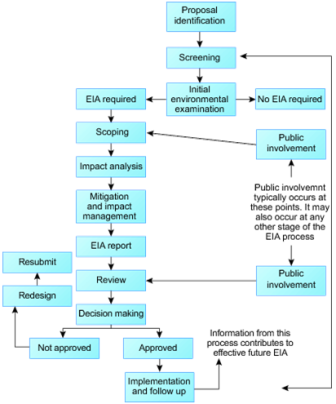2.9 EIA process
The main stages of the EIA process are shown in Figure 13.
Typically, the EIA report will cover the following:
- description of the project
- alternatives that have been considered
- description of the environmental context
- description of the possible significant environmental impacts
- mitigation strategies
- non-technical summary (usually the environment impact statement)
- assessment of knowledge gaps and/or technical difficulties.
There are many aspects of each stage that shape how the EIA is undertaken and its subsequent findings. Key to these are the interpretation of ‘significant’ and also the boundaries chosen to determine impacts.
Significant effects are determined with reference to a range of criteria relating to:
- possible environmental loss and deterioration (e.g. species loss)
- possible social impacts resulting directly or indirectly from environmental change (e.g. human health)
- possible non-conformity with environmental standards, objectives and guidelines (e.g. air quality standards)
- the likelihood and acceptability of risk (e.g. possibility of exposure to a hazard).
EIAs can be quite complex and technical, and are usually carried out by environmental consultants. Many large infrastructure projects will have an EIA of some kind. Some are more extensive than others. The EIA for High Speed 2, the high-speed rail proposal linking Birmingham and London, has an EIA of around 50,000 pages! While the EIA might be considered innovative in providing a systematic review of possible impacts, the EIA process and approach for understanding connections is not without its critics.

